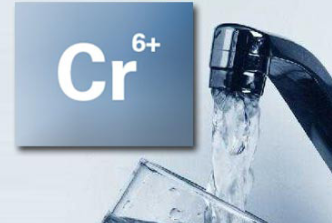Chromium 6 to Chromium 3
Published on by Water Network Research, Official research team of The Water Network in Academic
A team led by an engineer at Washington University in St. Louis found a novel approach to neutralize a cancer-causing chemical in drinking water.

Credit: Washington University in St. Louis
Chromium is an odorless, tasteless metallic element. One form, chromium-3, is essential to human health and is found in many vegetables, fruits, meats and grains and is often included in multi-vitamins. Its cancer-causing cousin, the chromium-6 infamous from the California exposure and Hollywood movie about Erin Brockovich, occurs naturally but is also produced in high quantities by industry, and can contaminate both soil and groundwater.
An engineer at Washington University in St. Louis has found a new way to convert the dangerous chromium-6 into common chromium-3 in drinking water, making it safer for human consumption.
 "The health effects are quite well-known. It's very potent as an inhaled contaminant, but in drinking water chromium-6 definitely has a negative impact on human health," said Daniel Giammar, the Walter E. Browne Professor of Environmental Engineering at the School of Engineering & Applied Science.
"The health effects are quite well-known. It's very potent as an inhaled contaminant, but in drinking water chromium-6 definitely has a negative impact on human health," said Daniel Giammar, the Walter E. Browne Professor of Environmental Engineering at the School of Engineering & Applied Science.
Scientists have previously converted chromium-6 to chromium-3 in a chemical process using iron. During the course of the new research, recently published in the journal Environmental Science & Technology , Giammar and his team took a novel approach, using electricity to do the job.
"Electrocoagulation is the particular approach we used to introduce iron into the water," Giammar said. "Typically, you would use an iron salt and physically add a dose to the water. Electrocoagulation uses two pieces of iron metal in the water, you apply a voltage between them, and that is how you dose iron into the water and convert the chromium-6."
Electrocoagulation systems are widely available, and Giammar finds using electricity as opposed to chemical alteration is an easier, more precise and scalable process.
"It allows you to tailor your dose in a very easy way," Giammar said. "Electronic controls can be easier than chemical feeding controls. It also allows it to be more applicable for remote operations, because you don't have to have a source of chemicals. You just use the same pieces of iron, and you can treat the water for a long time."
Giammar's team previously used the electrocoagulation approach to remove arsenic from drinking water; this is the first time it has been done to convert chromium in drinking water into a safer form. The next step: Researchers hope to use the same technique with selenium, a metal that's notoriously difficult to remove from water.
Source: Phys.org
Media
Taxonomy
- Treatment
- Heavy Metal Removal
- Decontamination
- Drinking Water
- Chemicals
1 Comment
-
This sounds like superfluous treatment technology. Chrome +6 is readily reduced to Chrome +3 by standard chemical reducing agents, Just like we all learned in freshman chemistry. Mr Giammar's statement about Chrome +6 in drinking water having a negative effect on human health is wrong. He should read and cite the current scientific literature, rather than the California regulations. Canada has read the current literature and they have retained their historic drinking water guideline of 50 ppb, which includes a substantial margin of safety. Chrome +6 at drinking water levels is immediately converted to Chrome 3 after ingestion because saliva and gastric juice are loaded with reducing agents. Humans have a very high reductive capacity in the GI tract.. Also, there are lots of groundwaters with natural Chrome +6. so we can't blame industrial discharges for everything.